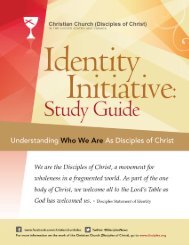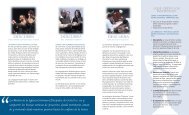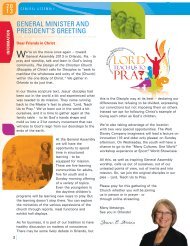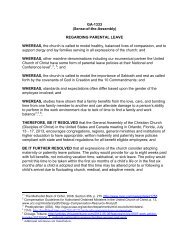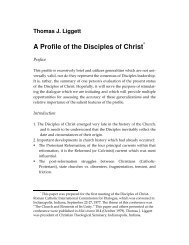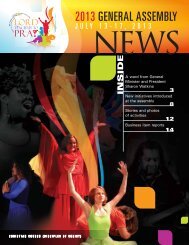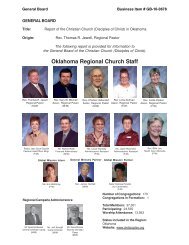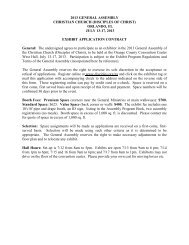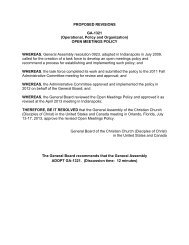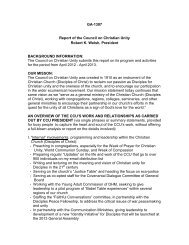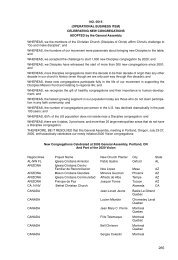RESOURCING THE CHURCH FOR ECUMENICAL MINISTRy A ...
RESOURCING THE CHURCH FOR ECUMENICAL MINISTRy A ...
RESOURCING THE CHURCH FOR ECUMENICAL MINISTRy A ...
Create successful ePaper yourself
Turn your PDF publications into a flip-book with our unique Google optimized e-Paper software.
When I hear this question of becoming a “multicultural and inclusive church” which was asked<br />
by the central culture, I hear something else. I hear their humility, I hear their compassion for<br />
embracing, and I hear their willingness to share.<br />
the identity issue which I think is important. The<br />
Disciples of Christ’s Identity Statement and<br />
Principles stated, “Identity is a vital concern for all<br />
parts of the church.” Identity shows what we are, who<br />
we are, and where we are. It shows our characteristics<br />
and traditions, and it displays our outlook<br />
accordingly. Identity is visible to others that they<br />
may see us and tell who we are, what we are and<br />
sometimes where we are. Each identity carries its<br />
own uniqueness, and that uniqueness can be<br />
displayed as an ornament of the ministry of God.<br />
My church’s extra distinction, if I could add, comes<br />
from our thinking that most of us are considered as<br />
the Korean-American generation 1.5. In this<br />
respect, we see ourselves as the generation who tries<br />
to live out our lives building a bridge between the<br />
First and the Second generation. With this sort of<br />
distinction, my church is proud to be called and<br />
identified as (Walking Faith) Korean-American<br />
Christian Church.<br />
Because of the identity issue, I will respond to the<br />
question of becoming a multicultural and inclusive<br />
church on a regional or denominational level. I am<br />
not saying that becoming a multicultural and<br />
inclusive church on the local church level is not<br />
possible, but I believe the question should be aimed<br />
at a wider church. Even on this level, dealing with<br />
the identity issue needs be addressed, since we have<br />
many members and not all the members have the<br />
same function (Romans 12:4). Therefore, to<br />
become a multicultural and inclusive church is to<br />
provide an opportunity to identify themselves.<br />
In the processing of identifying, I believe it calls one<br />
to examine oneself. As Socrates exclaimed, “Know<br />
yourself,” we need to know ourselves because we<br />
know that it is the beginning of our journey. When<br />
we identify who and what we are, and where we are,<br />
it allows us to see our placement and surroundings.<br />
The realization and recognition of one’s social<br />
location, as you know, is very important as it declares<br />
our presence among others and seeks to become<br />
part of that surrounding as well. As a cultural being<br />
I tend to see others as cultural beings. But I wonder<br />
how it may be possible that members of the central<br />
culture can be able to see themselves as cultural<br />
Kyung-min • Being a Multicultural and Inclusive Church in Era of Diversity<br />
16<br />
beings. I ask this because I believe that when they see<br />
themselves as cultural beings, then the word “multicultural”<br />
can be placed on a colorful spectrum.<br />
The understanding and embracing of others comes<br />
when there is enough opportunity for relationship.<br />
However, this relationship must be build up in the<br />
others’ context. Seeing others in their own context<br />
is good and important when we are relational<br />
beings. We need to know others in order to thrive.<br />
In this respect, becoming a multicultural and<br />
inclusive church means to provide opportunities to<br />
know others in context. Many times we tend to<br />
invite others into ours. The church has been<br />
inviting people to church. We are seeing gradually<br />
under the title of “missional church” that now<br />
people are trying to go out to see and visit others, to<br />
serve the needs of others. I believe it applies to the<br />
same idea of mission that, if we really want to know<br />
others, we should be able to spend some time with<br />
them in their context. “Let’s go to them.” Does this<br />
sound familiar? We all know that the Lord of grace<br />
came down from heaven to be with us in our<br />
context, to be related to us and show us the light.<br />
Providing opportunity to know others in their<br />
context is to provide them their own space to express<br />
themselves freely. In his book Reaching Out, Henry<br />
Nouwen describes the space as “where change can<br />
take place.” He goes further with this thought when<br />
he says that it is a place where others can enter and<br />
discover that they are created freely, where they sing<br />
their own song, speak their own language, eat their<br />
own food, dance their own dance, and celebrate<br />
their own distinct gifts.<br />
Lastly, to become a multicultural and inclusive<br />
church is to extend opportunities to reflect<br />
intentionally upon our commonality. For this<br />
intentional commonality I will direct us to our faith<br />
in Christ. We as church have one big fundamental<br />
thing in common, our worship of our God who is the<br />
only source of our unity. In the worship service we<br />
share our common experience—the grace of God<br />
through the seed of the Gospel. Becoming a<br />
multicultural and inclusive church should hold this<br />
in common since it is not only the only way to become<br />
a church like that, but it also sets our vision higher




